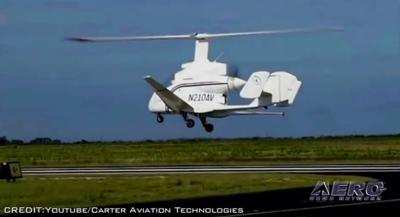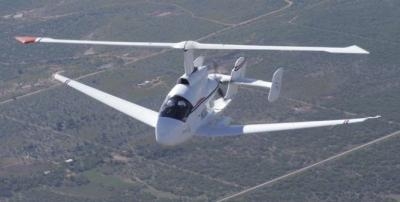Tue, Sep 15, 2015
Presentation Made At European Rotorcraft Forum In Europe
Carter Aviation Technologies last week made a presentation to the European Rotorcraft Forum in Munich Germany.

The European Union has been working on a program called Clean Sky for several years. This program seeks to improve environmental aspects of air transportation with reductions in CO2 emissions and noise pollution among the objectives. Recently, Clean Sky 2 was initiated with a consortium of participates, a multi-year plan, and a budget of around €4 billion between the European Union and industrial partners. Some of the loftier goals are a 20%-30% reduction in CO2 emissions and noise pollution with a 2014 technology baseline.
“I think we surprised a lot of folks in Munich. They’re workin a multi-year plan to create more environmentally-friendly aircraft and here we sit at Carter with a technology that achieves a reduction in CO2 between 66% [hovering aircraft] and 80% [jump takeoff aircraft],” expounded Jay Carter. “Our presentation created quite the buzz and we expect to be expanding our list of parties interested in learning more about our technology.” Carter’s Personal Air Vehicle or PAV pictured above has achieved an L/D of 11 and the potential to design an aircraft for an L/D of 16 is possible. The reduction in rotor drag achieved with the dramatic slowing of the rotor from a nominal takeoff maximum of 400 rpm to a cruise flight rotation of 100 rpm enables this level of cruise efficiency.

The idea of slowing the rotor down in flight is not new. In the 1930’s, aerodynamicists looking to improve upon autogyro efficiency recognized that if the rotor could be slowed down and kept stable, fantastic rotorcraft performance could be achieved in cruise. In the late ‘50s and early ‘60s, both the US and British governments spent years and millions of dollars trying to significantly slow the rotor. They had some success, but because
of noise, vibration, stability, and control issues, it was concluded to be either impossible or impractical. “We have been working the slowed rotor program for 21 years. It took 11 years before we first achieved an advance ratio of one. We had to identify and solve 10 issues to safely slow the rotor – the subject of 22 patents and 6 pending,” stated Jay Carter. The Carter presentation in Munich discussed those issues and the performance results from flight testing that have exceeded the emission and noise goals of Clean Sky 2.
(Images from file)
More News
Pilot Applied Full Aft Stick And Nose-Up Trim, But The Airplane Remained On The Runway Analysis: The pilot reported that a preflight inspection and flight control checks revealed n>[...]
A Few Questions AND Answers To Help You Get MORE Out of ANN! 1) I forgot my password. How do I find it? 1) Easy... click here and give us your e-mail address--we'll send it to you >[...]
From 2022 (YouTube Edition): Before They’re All Gone... Humankind has been messing about in airplanes for almost 120-years. In that time, thousands of aircraft representing i>[...]
Advanced Air Mobility (AAM) A transportation system that transports people and property by air between two points in the NAS using aircraft with advanced technologies, including el>[...]
Aero Linx: MQ-1B Predator The MQ-1B Predator is an armed, multi-mission, medium-altitude, long-endurance remotely piloted aircraft that is employed primarily as an intelligence-col>[...]
 NTSB Final Report: Douglas A-4K
NTSB Final Report: Douglas A-4K ANN FAQ: Q&A 101
ANN FAQ: Q&A 101 Classic Aero-TV: PBY Catalina--From Wartime to Double Sunrise to the Long Sunset
Classic Aero-TV: PBY Catalina--From Wartime to Double Sunrise to the Long Sunset ANN's Daily Aero-Term (07.01.25): Advanced Air Mobility (AAM)
ANN's Daily Aero-Term (07.01.25): Advanced Air Mobility (AAM) ANN's Daily Aero-Linx (07.01.25)
ANN's Daily Aero-Linx (07.01.25)




